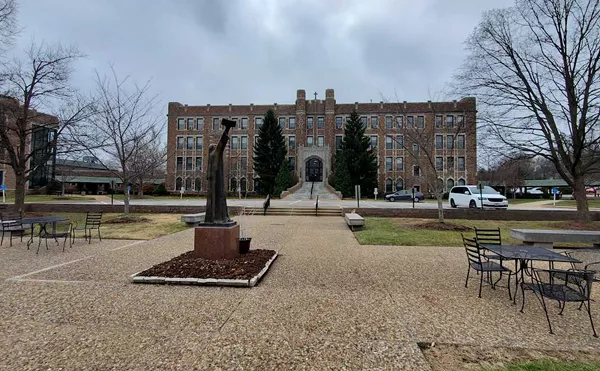To question the urgency or the importance of the $2.6 billion plan was to risk being cast as a Luddite, a no-growth nudnick. Or, if those voicing dissent happened to own one of the 2,000 homes or businesses being bulldozed for the new 9,000-foot W-1W runway, they were painted as not-in-my-backyard types, NIMBYs. The premise behind this panicky push to drive 5,400 people farther out into exurbia was that the airport was just so damn busy. And, of course, studies had shown and projections had been made about how damn busy the airport was going to be in distant years, like in 2000.
Well, get this: The number of take-offs and landings at Lambert is down this year compared with the figure for 1999, and it's on track for a six-year low. A visit to Lambert's own Web site shows that the number of "operations" at Lambert peaked in 1995 at 519,156. Last year, the total number of take-offs and landings, which make up the "operations" statistic, was 502,865. Back in 1991, a pro-expansion study predicted 541,000 operations by 2000; three years later, another study predicted nearly 513,000 by 2000. Both estimates were overly optimistic.
This year, through July, 8,000 fewer take-offs and landings were made than in the first seven months of 1999. Making a projection -- which, in this case, is at least reality-based -- would have this year's pace yield fewer than 490,000 take-offs and landings for this year, the lowest total since 1994.
No one with any sense -- certainly no one who's flown in or out of Lambert recently -- will argue that the airport is just fine the way it is. It's busy, it's crowded, and all the food, particularly the beer, is way overpriced. And airports are like hospitals; they're always under construction, so something always needs to be done. But what the anti-W-1W types are saying is this: The urgency is not what it was painted to be. Because Lambert's air-traffic controllers and TWA pilots say the W-1W expansion will not appreciably improve the airport, let's do one last thing to see whether W-1W will work. The TWA pilots' union wants a "real-time simulation study" to prove or disprove the concerns about the expansion. A real-time simulation test would have live air-traffic controllers sitting at radar screens dealing with live pilots, unlike the previous tests, which relied on computer programs. Col. Leonard Griggs, Lambert's impresario, doesn't want to fool with such a study.
One aviation consultant who's against W-1W, Joe Lintzenich, says the few months and $60,000 it would take the Federal Aviation Administration to conduct the real-time study would be worth it. "The number of flights is going down. We already know Lambert can handle 519,000 flights -- it already did -- so there is no reason to rush," he says. The declining number of flights doesn't argue that expansion is not needed, Lintzenich says, but "it gives you time to find out if this expansion is worthwhile. They say there's not enough time -- there is enough time."
Defenders of the faith point out that despite the drop in the number of flights, a growing number of people funnel through Lambert. Last year, 15 million people boarded planes at Lambert, up from 14.3 million in 1998. Asked to explain the conflicting set of statistics for decreasing numbers of flights and increasing numbers of passengers, a Lambert spokesperson issued this terse statement: "Passenger totals have increased 5.4 percent due to larger, more advanced aircraft with greater load factors. Operation totals fluctuate. There is still the need for the additional runway to reduce delay cost. The need has not diminished."
Any discussion of delays, just how they are measured and how they will change with W-1W is guaranteed to put even a meth freak to sleep. So let's just point out a couple of facts: TWA and Southwest, the two dominant passenger carriers at Lambert, were, respectively, the nation's No. 1 and No. 2 "on-time" performers among passenger airlines for 1998 and '99. And, according to the FAA, Lambert dropped from seventh place among airports for delays in '98 to 13th last year. So, at least from a passenger's viewpoint, delays have not gotten appreciably worse.
But each side of the Battle of Lambert can quote statistics like a televangelist can quote Scripture, often with about as much zeal and credibility. But this much is clear -- the people who should know what they are talking about, the pilots and air-traffic controllers, don't think W-1W is worth it. They want one more test to show that. And the numbers are curious: Fewer flights are landing and taking off. Those backing the W-1W boondoggle have their FAA "record of decision" in hand and have won a key state appellate-court decision, so they think they're out of the woods.
But they're not, even if they get W-1W built. Judging from their own projections, delays and capacity again will start to be problematic by 2015. And whoever succeeds Griggs will be hamstrung as badly as the landlocked airport, especially now that Boeing Corp. and the airport authority have struck a land deal that excludes any option Lambert had to expand to the north.
With Lambert's growth blocked in virtually every direction, if W-1W fails to greatly improve capacity or efficiency, there appears to be one solution after 2015: Mid America Airport in Illinois. Those looking to the future might start buying up parcels over near Swansea.





